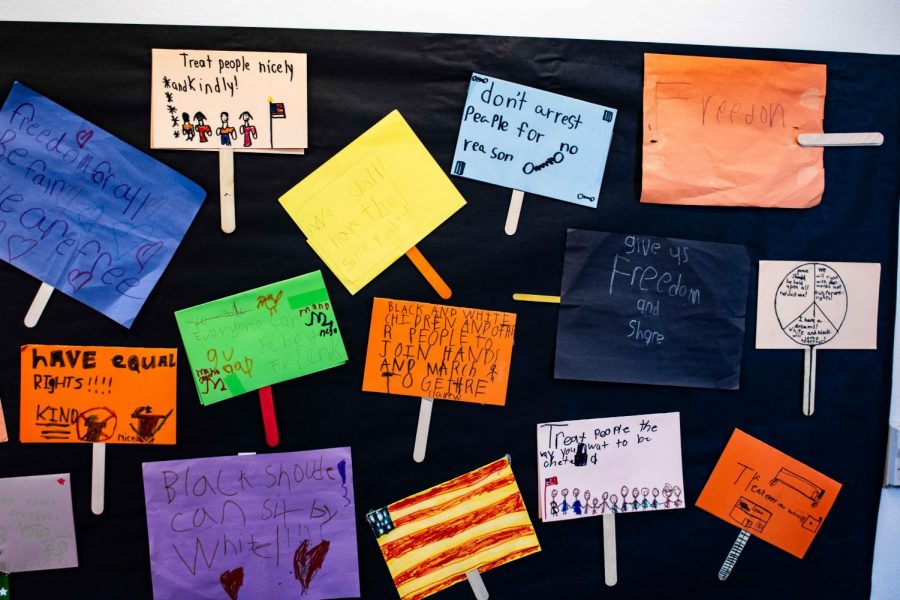Teaching the movement through art
The Whitman Teaches the Movement exhibition in the Stevens Gallery features protest signs made by students in the Walla Walla Public School District. Photo by Carson Jones
March 12, 2020
Colorful protest signs, collages and puzzle pieces line the walls of the Stevens Gallery, with bold children’s handwriting standing out in every corner. The exhibit is a showcase of what Whitman Teaches the Movement does in Walla Walla Public Schools.
Whitman Teaches the Movement is a partnership between the Whitman Student Engagement Center and Walla Walla Public Schools where Whitman students visit local schools to teach lessons regarding social justice issues. The gallery is a showcase of some of the student art that has come out of these lessons.
“Whitman Teaches the Movement has a drawer in the Student Engagement Center and the drawer is notorious among the other interns for just being loaded with all this art from over the years, all this incredible art that kids have done in the lessons,” said senior history major Andy Burnstein, the program leader of Whitman Teaches the Movement.
Burnstein explained that there was an opening in the Stevens Gallery in Reid, so they decided that Whitman Teaches the Movement could showcase some of its art there. He added that there were different art projects for different grade levels and that some of the gallery was interactive.
“The kids make a puzzle piece that represents their identity and then they all glue it together and then it’s like out of all these diverse people it’s one community,” said Burnstein on one of the projects being showcased. “So the interactive portion of the exhibit is people make their own puzzle pieces then [gluing] them all together … like we’re all one community.”
The teachers from the schools that Whitman Teaches the Movement partners with had a lot to say about the program, most of it positive.
“Kindergarten is not too early for students to begin to become aware of biases each of us hold. Being able to name those biases, and to name why our biases are unfounded, is an important conversation for even the youngest members of our society. Whitman Teaches the Movement exposes kindergarten students to these important issues and conversations so they will realize they each have a voice that will affect our society,” said Suzann Rose, a kindergarten teacher at Prospect Point Elementary School.
Rose also said that she greatly appreciates all the work the Whitman volunteers put into the lessons and connecting with kids.
“With care and facts, and in a grade-appropriate presentation, the Whitman Teaches the Movement representatives have consistently provided lessons that allow kindergarten students to consider the similarities we share that allow us to be respectful of our differences,” Rose said.
Other teachers agreed. Jennifer Holbrook, a second-grade teacher at Berney Elementary School, added that she appreciates the community-focused aspect of the program.
“It is great for our kids to connect with others in our community and for the community to connect with our kids,” Holbrook said.
David Parodi, a fifth-grade teacher and district elementary science teacher, said he was especially interested in this year’s project.
“This year’s focus on being an activist and creating a mural to support your ideas and thinking seemed like something I wanted to explore further with my fifth graders, so I invited the Whitman students in to do the lesson,” Parodi said. “[The fifth-graders] enjoyed the thinking and [the] project that the student leaders presented. I enjoyed and am enjoying the follow-up conversations with my fifth-graders.”
However, Parodi noted that he has only participated a few times in the many years he has known of the program, saying that the student-taught lessons are either too close to what he is already teaching in his classroom or do not line up with his focus. Parodi explained that he thought the lessons are best used to inspire a conversation that should be happening year-round.
“Teaching civic responsibility is important, as one has to know how to engage in responsible discussion and expression in order to be a productive citizen. This shouldn’t come from one lesson done by Whitman volunteers, but rather from the classroom teacher on a regular basis in a thoughtful manner. Whitman Teaches the Movement may be a ‘seed’ planted for teachers and students alike,” Parodi said.
Burnstein agrees that social justice education should be part of a normal school curriculum.
“I think [Whitman Teaches the Movement] is really important for the community because social justice education is not systematized in the curriculum fully, and so [it is] bringing a sort of curriculum that many kids are not getting unless their teachers are doing it on their own volition,” Burnstein said.
“For the question of why is [this kind of] education important… at all, I just think to not teach about the darker parts of our history is denialism, and you’re bound to repeat what you don’t teach,” Burnstein added. “And so I think the lessons are encouraging the kids to, one, learn the facts of American history, two, to have more empathy for people who are not like them, who are different from them, [and] to recognize inequality and discrimination in the world around them today.”
Burnstein added that Whitman Teaches the Movement doesn’t just teach lessons for kids, but organizes events within the Whitman community as well. Students are always encouraged to participate in these activities.
The exhibit in Reid will be open until break, and visitors are invited to make their own puzzle pieces and consider their part in the community.





